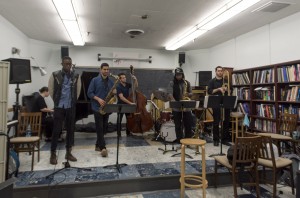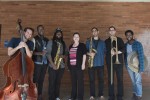Pianist Carmen Staaf said her favorite memory with the Thelonious Monk Institute of Jazz was playing at the open-air El Badi Palace in Marrakech, Morocco.
The Thelonious Monk Institute Ensemble is comprised of seven student musicians who were accepted into the graduate program in 2014 from a variety of musical backgrounds and age groups. They will graduate this year with master’s degrees in music from the UCLA Herb Alpert School of Music.
During the Marrakech performance, Herbie Hancock, a famous jazz musician on tour with them, was performing a piano solo when the Muslim call to prayer – a traditional daily Arabic recitation – began playing over a loudspeaker.
“It was this incredible experience of what we were doing at that moment, the cultures coming together and us getting to also experience being in this other place but playing for these audiences who were so appreciative,” Staaf said.
The group has traveled around the world, playing high-profile gigs. They performed at the White House in April as part of International Jazz Day and joined famous jazz figures Wayne Shorter and Hancock onstage at the Playboy Jazz Festival in June 2015.
West Coast Director Daniel Seeff described the live audition process as a bit of a mix and match; roughly 30 players make it through a first round of recorded auditions and travel to Los Angeles.
There, they are placed in random groups with one person on each instrument. They play in front of a panel of judges who, after hearing each group play, test out musicians from different groups together to find the ones who have the best chemistry.
When the students were first selected to be a part of the program, Seeff said they knew spending long periods of time with the same seven people for two years would not be easy.
“Applicants need to have the personal ability to get along with a small group of people for two years,” he said. “You see the same people every single day, you have to work with them, you have to compromise.”
Bassist Alex Boneham moved from Sydney, Australia, to join the ensemble. He said although the members know each other well now, a huge part of the program is learning to work with strangers.
“It’s not uncommon to get on a gig and not know anyone in the band before you play the first gig,” he said. “And so (the program) is like a really intensified extension of that. It’s like being on tour for two years, being on the road, staying in the same hotel room every day.”

Boneham said having music as a common language helped the students work together. Being in the program helped both Boneham and Staaf see jazz as a global art form connecting people across cultures. Staaf did not realize how broad the focus of her education at the institute would be until she got there.
“(The Monk Institute) isn’t just about the music and about me,” Staaf said. “It’s about a vision for how I can live my life as a human who’s doing music but with this sense of it being relevant to the world at large.”
The students’ disparate backgrounds influence the way they approach their music, Staaf said. Boneham said the ensemble’s tenor saxophonist Daniel Rotem is from Israel, and as a result, much of his music draws on Middle Eastern folk music.
Boneham said musicians are also influenced by their previous instructors in addition to their home scene and background, which shows in their work with the ensemble.
Christian Euman, the ensemble’s drummer, grew up in Chicago playing in the church, but he studied with influential instructors like Maria Schneider, who caused him to incorporate the big-band tradition into his work, Staaf said.
Each player’s background and influences come together when the band refines a player’s original composition.
“One player brings in a piece of music that they’ve composed, which is their idea, their concept, and then it gets workshopped by the group,” Boneham said. “The music by nature is inherently collaborative.”
All the players also have their own strengths, Boneham said. In the past, he has turned to the ensemble’s singer, Michael Mayo, to help him write lyrics.
After graduation, the members of the ensemble hope to get back into the jazz scene with more confidence in their artistic visions, Boneham said.
Staaf said the institute helped validate her interest in many different styles of music in addition to jazz.
“I feel more at home with myself as a ‘jazz plus’ musician,” Staaf said. “So (my) artistic vision … is a conversation with other cultures where jazz is the moderator.”
